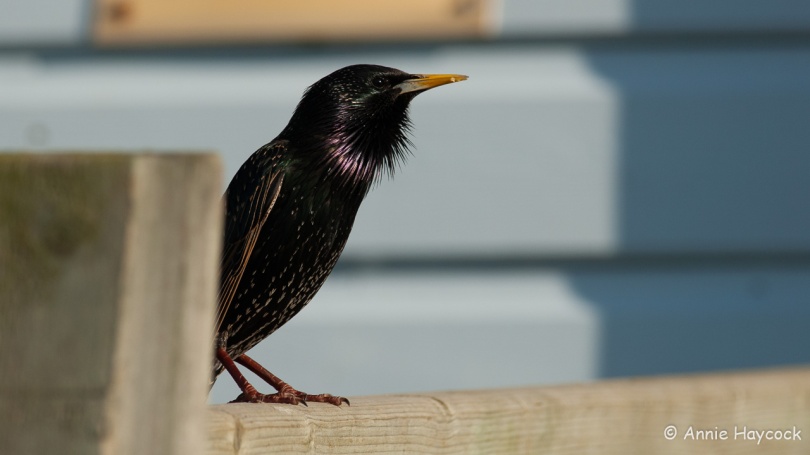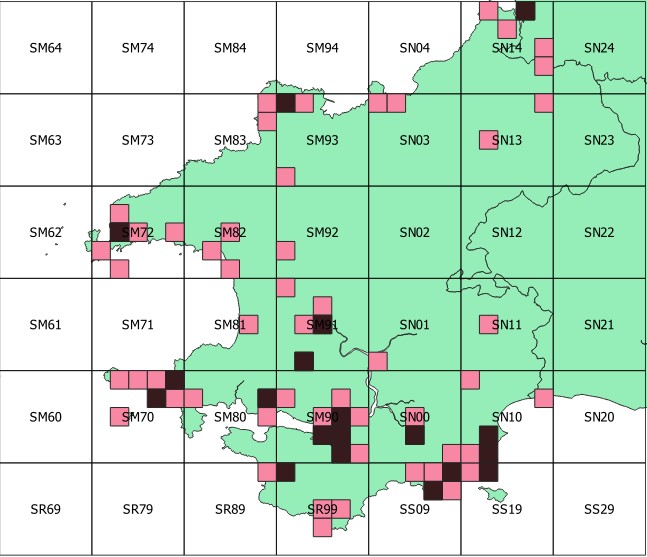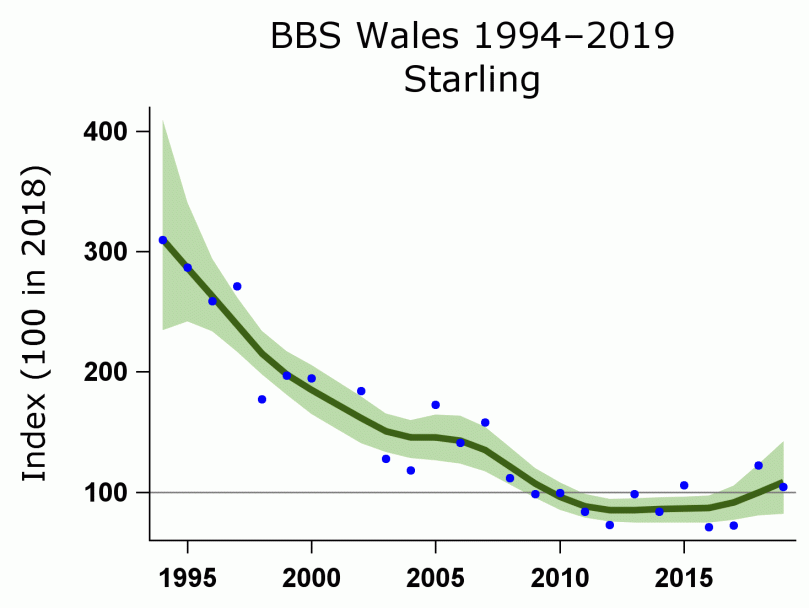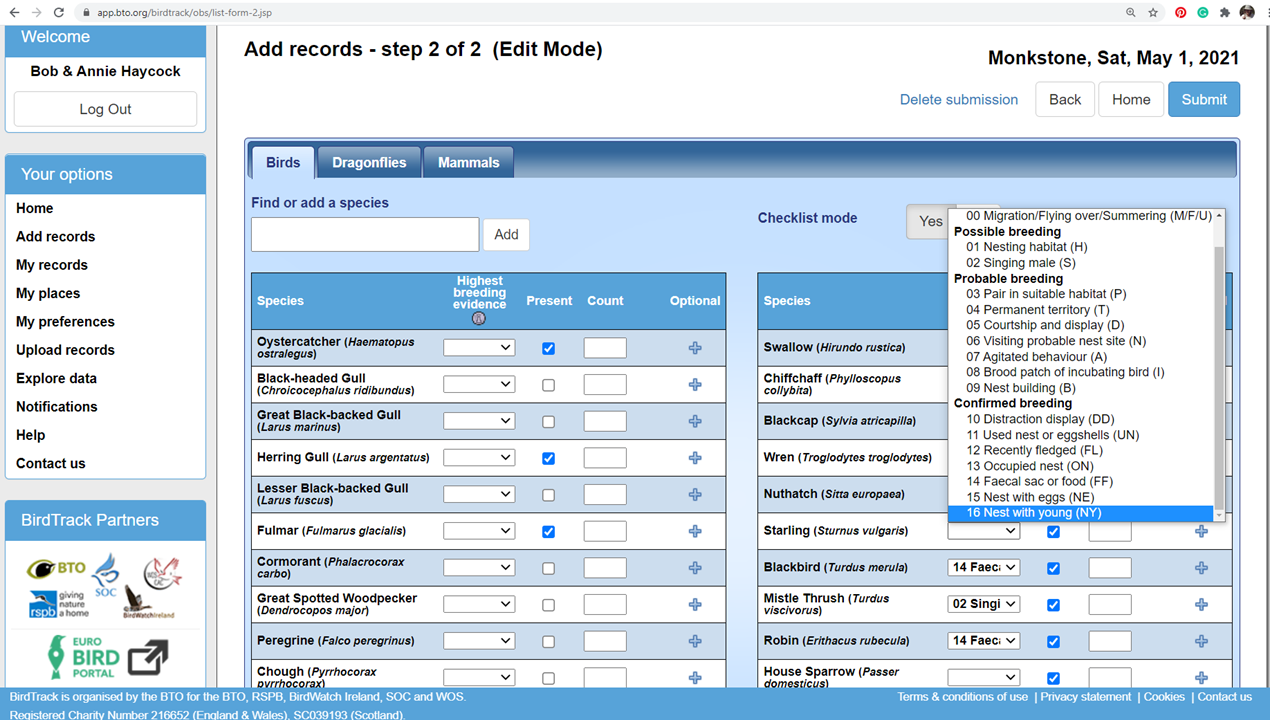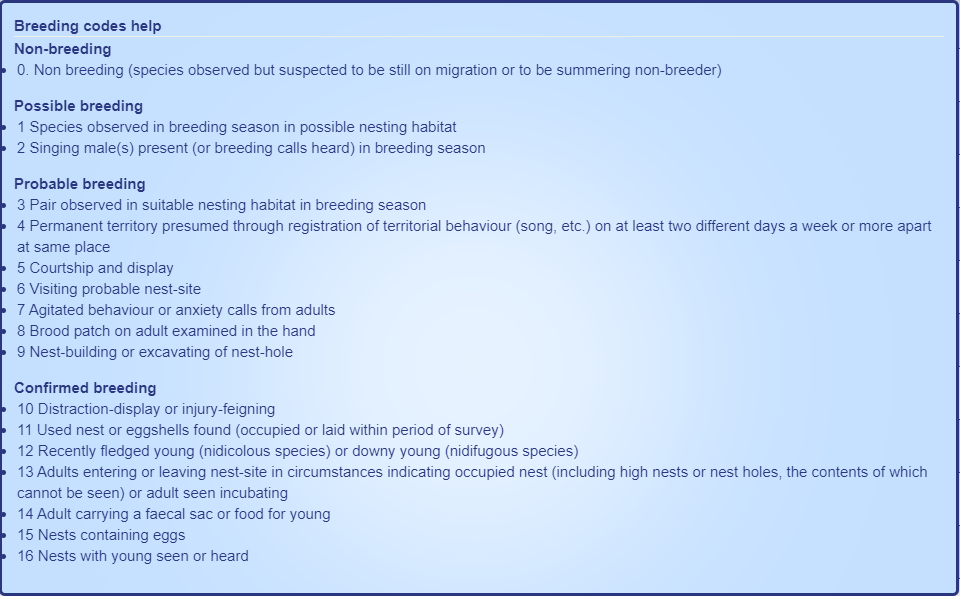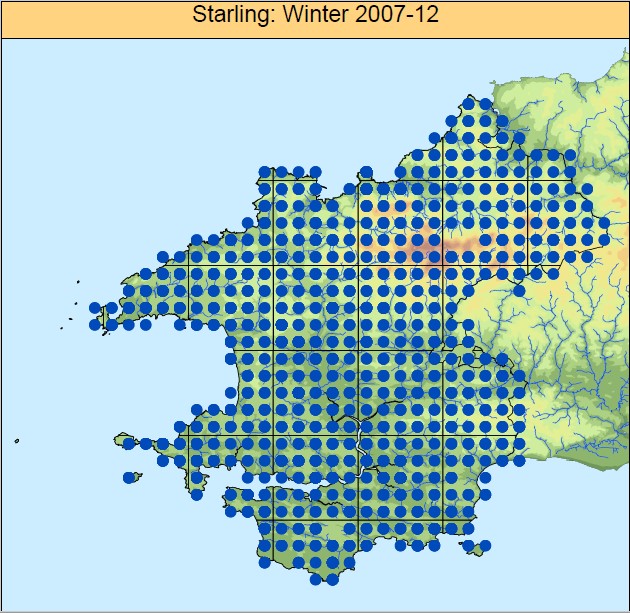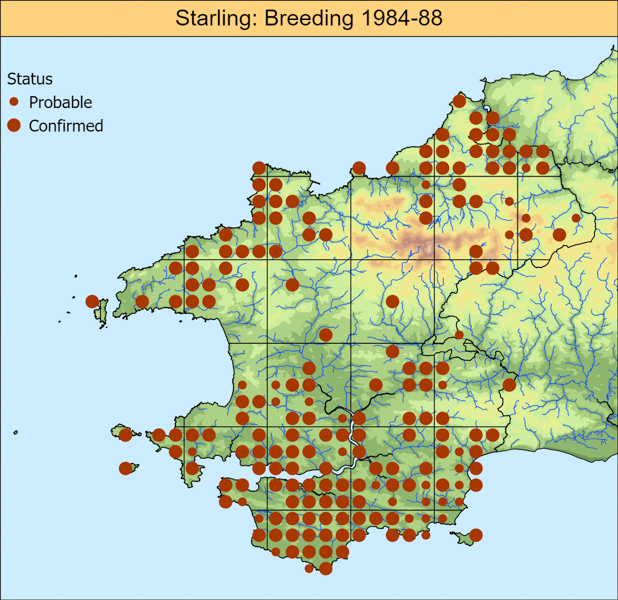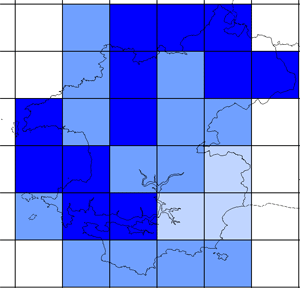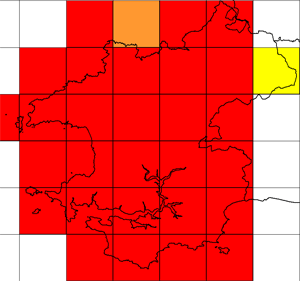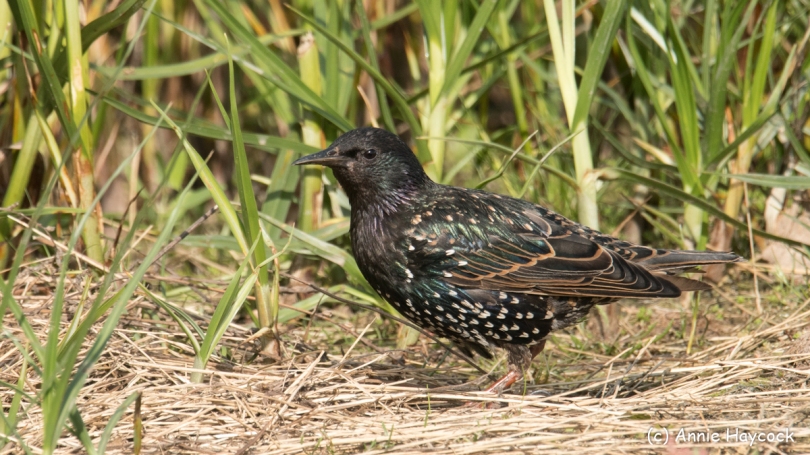Sturnus vulgaris – DRUDWEN – Breeding resident, winter visitor and passage migrant
Starlings are well-known for their large winter roost gatherings. The following roost data have been extracted from the Pembrokeshire Bird Reports, and the archive kept by the late Graham Rees. Not all roosts are reported every year, so the absence of a record does not necessarily equate to the absence of a roost.
| Year | Month | Place | Count | Notes |
| 1983 | Dec | Dudwell | 1,500,000 | Feeder lines from SM70, SM72, SM80, SM81, SM82, SM83, SM90, SM92, SM93, SN00, SN01, SN02, SN03, SN11 |
| 1984 | Jan-Mar | Dudwell | 2,000,000 | |
| 1984 | Oct | Dudwell | Used from June onwards | |
| 1984 | Maesgwyn/Pantmaenog | SN089290 large roost on FC land, not used before | ||
| 1985 | Jan | Dudwell | 2,000,000 | |
| 1985 | Feb | Pantmaenog | 200,000 | |
| 1985 | Nov Dec | Bosherston | 30,000 | Dudwell and Pantmaenog in use. Additional roosts at Canaston Woods |
| 1985 | Dec | Frolic Reedbed HW | 100 | roosting |
| 1986 | Jan Feb | Bosherston | 100,000 | Roosting in reedbeds during cold spell |
| 1992 | Dec | Bosherston | 2,000 | Roosting in reedbed |
| 1993 | Frolic reedbed | 1000 | Roost gathering | |
| 1994 | Dudwell | Roost still in use | ||
| 1994 | Pantmaenog | 200,000 | ||
| 1995 | Jan-Mar Sep-Dec | Teifi Marshes | 100,000- 150,000 | |
| 1996 | Dec | Teifi Marshes | 100,000- 150,000 | |
| 1997 | Oct | Teifi Marshes | 65.000 | |
| 1998 | Oct | Teifi Marshes | 6,000 | |
| 1999 | Oct | Pantmaenog | 1,000,000 | A bird found dead 6/2/99 at Dudwell had been ringed as a 1st year at Llitnoller, Denmark, on 4/9/95 |
| 2001 | Jan | Slebech | Many thousands going into reedbed | |
| 2001 | Jan | Teifi Marshes | Many thousands going into reedbed | |
| 2001 | Oct | Dudwell | 200,000 – 300,000 | Roost decreased by half in last ten years |
| 2006 | Nov | Slebech | 70,000+ | |
| 2006 | Dec | Slebech | 300,000+ | |
| 2006 | winter | Bosherston | 25,000 | Central Lake reedbed |
| 2007 | Nov | Slebech | 90,000 | |
| 2007 | Nov | Slebech | Disappointing with only a few thousand birds on 27th | |
| 2008 | Oct | Teifi Marsh | 1,000+ | Roost increasing |
| 2008 | Nov | Slebech | Several thousand | |
| 2008 | Nov | Plumstone | Photos of murmuration | |
| 2009 | Jan | Plumstone | Plenty of starlings – aerial displays | |
| 2009 | Oct | Slebech | Many thousands | |
| 2009 | Nov | Teifi Marshes | 5,000 | |
| 2009 | Nov Dec | Dudwell | 1,000,000+ | |
| 2010 | Feb | Plumstone | 1,000,000+ | |
| 2010 | Dec | Plumstone | 1,000,000 | |
| 2010 | Oct | Slebech reedbed | 100,000+ | |
| 2011 | Feb | Plumstone | 1,000,000 | |
| 2011 | Nov | Teifi Marshes | 50,000 | On 4th, but only 7-8,000 next evening |
| 2011 | Nov | Slebech | 5,000 | Only a few thousand on the 4th |
| 2012 | Jan | Plumstone | Millions | |
| 2012 | Mar | Llys-y-fran | 1,000+ | Dropping into conifers |
| 2012 | Oct | Castlemartin Corse | occupied | |
| 2012 | Oct | Slebech | Tens of thousands | |
| 2012 | Nov | Plumstone | 30,000 | |
| 2013 | Jan | Plumstone | 100,000 | |
| 2013 | Nov | Plumstone | Roost as magnificent as ever | |
| 2014 | Nov | Castlemartin Corse | 50,000 | |
| 2014 | Nov | Slebech | 50,000 – 100,000 | |
| 2014 | Dec | Plumstone | 20,000 | Part of roost site had been felled |
| 2014 | Dec | Castlemartin Corse | 100,000 – 150,000 | |
| 2015 | Jan | Dudwell | 2,000 | Roost much depleted, down to 500 on one evening |
| 2015 | Oct | Teifi Marshes | 5,000 | Between Creek Hide and the river |
| 2015 | Dec | Slebech | 250,000+ | |
| 2015 | Dec | Teifi Marshes | 30,000 | |
| 2016 | Jan | Teifi Marshes | 50,000 | |
| 2016 | Jan | Slebech/Pickle Wood | 50,000 | |
| 2016 | Nov | Teifi Marshes | 20,000 | |
| 2016 | Nov | Slebech reedbed | 70,000 – 100,000 | |
| 2016 | Dec | Slebech/Warren Wood | 100,000+ | Roosting in Mescanthus fields towards the A40 |
| 2016 | Dec | Teifi Marshes | Large murmuration | |
| 2016 | Dec | Plumstone | Large murmuration on 4th | |
| 2016 | Dec | Dudwell | Unoccupied on the 27th | |
| 2017 | Jan | Slebech | 50,000 | |
| 2017 | Jan | Slebech/Pickle Wood | 100,000 | Roosting in Mescanthus |
| 2017 | Feb | Llanwarren-Jordanston | Possible new roost? | |
| 2017 | Oct | Slebech reedbed | 30,000 – 50,000 | |
| 2017 | Nov | Slebech reedbed | 100,000 | |
| 2017 | Dec | Slebech | Roosting in Mescanthus | |
| 2018 | Jan | Slebech | 250,000 | |
| 2018 | Oct | Slebech | 50,000 | |
| 2018 | Oct | Castlemartin Corse | 10,000 | Heading from Marloes towards Castlemartin |
| 2019 | Oct | Teifi Marshes | 3,000 | |
| 2020 | Nov | Slebech reedbed | 100,000 – 150,000 | |
| 2020 | October | Teifi Marshes | 1000 | |
| 2021 | Jan & Feb | Slebech Miscanthus | c.100,000 | Birds near Haverfordwest. Most likely heading to roost at Slebech Miscanthus. This was the main roost site occupied in winter 2020/21. |
| 2022 | Jan | Castlemartin Corse | 50,000 | Reported from the area on 20th January |
| 2022 | Nov | Slebech | 10,000 | Reported near Haverfordwest on 19th Nov. Presumed to be birds heading towards the Slebech roost. |

